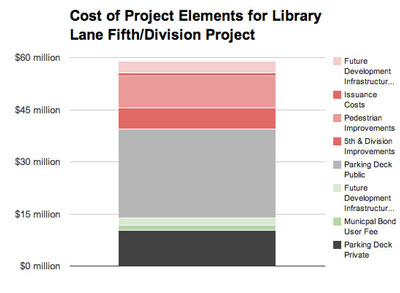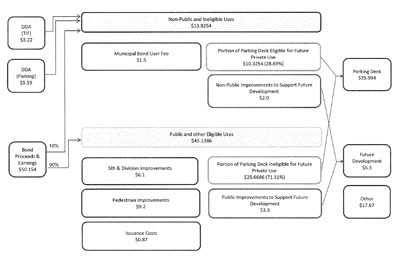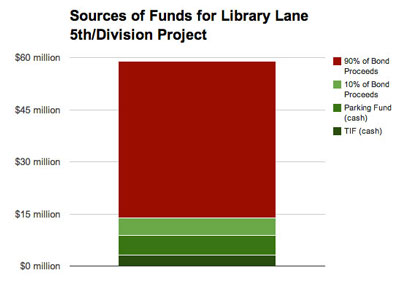Column: Rocking Back on the Library Lot
Collectively, we residents of Ann Arbor are a little bit like an old man who sits in a rocking chair telling the same old stories over and over again to anyone who will listen. Before we start, we do not say: Stop me if you’ve heard this before. Because even then we would not stop.

This illustration is a mashup of a photo taken on July 12, 2012, the day of the grand opening of the Library Lane parking structure, and a photograph from the author’s family archives on which an original lyric is based: “I’m an old man, and I don’t care, I’m sitting here in my rockin’ chair, watching the mean old world go by …”
And so it is that we’ll talk about the nuisance of the deer herd in 2008 … and again in 2014. We’ll talk about slush puddles in the downtown in 2009 … and again in 2014.
We talk about those things not because we suffer from community-wide senility, but rather because they are issues that remain in some way unresolved.
And that is why we are again talking about the top of the Library Lane underground parking structure in downtown Ann Arbor. The project included not just the parking deck itself, but also streetscape improvements to Fifth and Division, other pedestrian improvements, and investments in foundations and other work to support future development – a total of about $59 million worth of stuff.
The bulk of that cost was financed through Build America Bonds. What are the implications of the BAB financing for the future use of the parking structure’s spaces? That’s the question prompting me to write this column. I’d like to orient the public to the city’s analysis of how those spaces can be allocated to private uses.
Related to that, a resolution to be placed on the city council’s March 17 meeting agenda by the council audit committee is good news. The resolution would waive attorney-client privilege on a document that I think will help clarify questions associated with those bonds.
But I want to fill in some background first. Stop me if you’ve heard this before.
Library Lane: Background
The Library Lane project finished construction in the summer of 2012. At that time no specific plan was in place to take advantage of the fact that more than 700 parking spaces had been constructed underground. The spaces were consciously and deliberately constructed underground so that the area above those 700 parking spaces could be put to a greater and better use than simply parking cars. Yet that is how we’re now using the surface of the Library Lane parking structure – to park cars.
So what will go on top?
Of course, we’ve talked about this before. The conversation is documented in The Chronicle’s archives at least a half decade ago, and I’m sure the conversation stretches back years before that. At the March 4, 2009 meeting of the Ann Arbor Downtown Development Authority board, Sandi Smith introduced a resolution of support for a community-wide process to decide what the future of the top of the structure should be: “[Smith] said that [the resolution] was prompted by the dialogue about the underground parking garage, which had prompted the frequent question from residents: What goes on top?”
That DDA board resolution came just a couple of weeks after the city council voted at its Feb. 19, 2009 meeting to approve the site plan for the parking structure and the notification of intent to issue bonds to pay for it.
Fast forward through an RFP process that ended in a rejected conference center proposal, a planning effort called Connecting William Street that never was incorporated into the city’s master plan, and finally a set of recommendations from the city’s park advisory commission (PAC). The PAC report was made last year on Oct. 15, 2013, and forwarded to the city council. Three weeks later, the council formally accepted the report from PAC on Nov. 7, 2013.
Between November 2013 and February 2014, the only somewhat visible effort on the council to move the what’s-on-top issue forward was by Ward 4 councilmember Jack Eaton, who worked with the Library Green Conservancy to craft a resolution that appeared on the council’s March 3, 2013 agenda. Eaton’s resolution – his first to be put forward since his election to the council in November 2013 – incorporated elements of PAC’s recommendations.
But the fact that Eaton’s resolution was not necessarily consistent with all aspects of PAC’s recommendations was reflected in the sentiments of PAC’s current and immediately previous chair, Ingrid Ault and Julie Grand – who both addressed the council on March 3 expressing their concerns about the resolution.
Eaton’s resolution spurred mayor John Hieftje to counter at the March 3 meeting with a slide presentation sketching out a connected walk from Liberty Plaza to the planned Allen Creek greenway, linking up public open spaces at Library Lane, the corner of Fifth and William, William and Main, and First and William.
Eaton’s resolution was postponed, and will appear on the council’s March 17 agenda.
Implications of a Companion Resolution
Meanwhile, Ward 3 councilmember Stephen Kunselman will be putting forward a companion resolution on March 17 directing the city administrator to hire a real estate broker to handle the sale of the rights to build something on top of the Library Lane parking structure. That approach would be similar to the path the city council took to sell the old Y lot. That sale is now set to close on April 2 – according to city administrator Steve Powers, who responded on March 12 to an emailed query from The Chronicle.
I think Kunselman’s move has some implications for Eaton’s resolution, because part of the immediate audience for that resolution will be developers who are interested in making an offer. So one potential function of Eaton’s resolution – which it does not currently serve in an explicit way – is to lay out the universe of possibilities for elements that a rider agreement to a sales contract might include. A rider agreement – to ensure against non-development and to sketch out the amount of open space and density – was the approach the city took to the old Y lot deal with hotelier Dennis Dahlmann.
Responding on March 11 to an emailed query from The Chronicle, Eaton indicated that he was working on some modifications to the resolution for March 3 March 17, but didn’t say what the nature of those modifications would be.
Build America Bonds: Clarity on the Issue
Kunselman’s effort to move the building rights into the real estate marketplace will, I think, have a positive impact on the clarity of the information that the city will need to provide – about an issue related to the use of Build America Bonds to finance the Library Lane project.
In broad strokes, the American Recovery and Reinvestment Act (ARRA) of 2009 – also known as the stimulus act – created the Build America Bond program. BAB authorized state and local governments to issue taxable bonds to finance any capital expenditures for which they otherwise could issue tax-exempt governmental bonds. The bonds have a limitation related to how the facilities financed through such bonds can be used. Glossing over details, only up to 10% of a facility financed through BAB can be dedicated to private use.
A clear example of a private use of the Library Lane parking facility, I think, would be a hypothetical contract between the Ann Arbor Downtown Development Authority (which manages the city of Ann Arbor’s parking system) and a downtown business – to purchase monthly parking permits in the Library Lane structure. The 48 monthly parking permits that the 624 Church Street residential project was allowed to purchase through the city’s contribution-in-lieu (CIL) program would seem to fit the criteria of “private use” of a facility. But those permits were awarded in the Forest Street structure, not Library Lane.
All other things being equal, the Ann Arbor DDA does not contract with businesses for monthly permits. Instead, the DDA contracts with individuals on a first-come-first-serve basis.
Still, for the Library Lane structure, the DDA offered introductory pricing of its monthly permits to encourage the structure’s initial use. And the nature of that introductory pricing scheme could prompt questions about whether some of those permits might properly count as “private use” of the structure. A $95 introductory rate (which reflects a $50 savings over most other structures) was offered to employees of “new to downtown businesses” and to permit holders in the Maynard or Liberty Square parking structures who were willing to transfer their permit to Library Lane. The pricing is good through August 2014.
Two years ago, Barracuda Networks was moving to downtown Ann Arbor, and therefore qualified as a “new to downtown” business. So its employees thus qualified for the discounted monthly parking permits.
In a July 13, 2012 email to Ward 2 councilmember Jane Lumm, DDA executive director Susan Pollay wrote in part:
I met with the two key individuals directing the Ann Arbor Barracuda office and told them point blank, that that there will be parking for Barracuda employees now when they move to downtown, and as they grow their employee ranks over the next few years.
To the extent that Barracuda employees (or employees of other downtown businesses) have privileged access or enjoy an economic advantage (like reduced rates), then I think it’s conceivable that the private use test could be met for those spaces. But short of a legal opinion provided by an expert in the field of private/public use issues, it’s hard to say for sure.
Four years ago, Wayne State University professor of law Noah Hall, writing on behalf of the Great Lakes Environmental Law Center (GLELC), sent the city of Ann Arbor a letter on the BAB private use issue. [For more detail, see his letter: April 14, 2010 letter from Noah Hall] GLELC was a party to a lawsuit filed over the Library Lane parking structure, which eventually was settled.
The need to provide absolute clarity on this issue to any potential purchaser of building rights on top of the Library Lane structure will, I think, work to the benefit of us all. That’s because I think that same kind of information will also be provided to the public.
In the meantime, The Chronicle has appealed a partial denial of a request made under Michigan’s Freedom of Information Act to the Ann Arbor city council. One of the items denied in response to the request was a memo with the file name: “BHO 1-# 1607254-v8-Ann_Arbor _ -_Memo_re_Permitted_Parking_Arrangements.docx” The request for that document was denied based on the statutory exemption allowed for items protected under attorney-client privilege. But it sure sounds like it could provide some clarity on the question of whether certain monthly parking arrangements are public or private uses.
We made the original request under the FOIA of the council as a public body, not the city of Ann Arbor as a municipality – so that our appeal would be properly made of the council itself as the head of the public body. The city attorney’s office does not appear to be persuaded by our legal theory of the proper venue of appeal – because the response to our appeal came from city administrator Steve Powers. The letter from Powers upheld the denial.
However, the members of the city council’s audit committee have placed a resolution on the council’s March 17 agenda to waive attorney-client privilege on the document in question. That’s a good thing. It will be even better if it gets the six votes it needs for approval.
The City’s Analysis: 28.69%
It’s not like the city of Ann Arbor has refused to provide any information at all about its analysis of the Build America Bond 10% limitation on private use. In fact, at the council’s audit committee meeting on March 10, CFO Tom Crawford circulated a box diagram laying out how the city arrived at the conclusion that 28.69% of the parking spaces in Library Lane could be dedicated to private use.
I have a bias against boxes and arrows, so I took the same information in that chart and recast it as a series of three bar charts. Shades of red represent funding that must go into public use parts of the facilities. Shades of green represent funding that can go into private use parts of the facilities: the DDA’s cash contribution (from parking system revenue and tax increment finance revenue) plus 10% of the bond proceeds.
Key is that the DDA’s initial cash down payment can, according to the city’s analysis, be used to finance a portion of the facility that is not subject to any use conditions (i.e., can be dedicated to private use). All the sources of funds for the nearly $60 million project are laid out in Chart 1:
Sticking with the idea that red shades correspond to funding associated with a public use requirement, while green shades correspond to funding that allows private use, the money spent on project elements are presented in Chart 2. Important here is recognizing that the project scope included far more than just a parking deck.
Chart 3 is just a re-presentation of Chart 2, but highlights the two parking deck portions of the project in black and gray:

Chart 3: Cost of project elements for Library Lane Fifth and Division Project. Focus on parking deck.
The pie chart was constructed using just the two parking deck portions from Chart 3:
The animation below just cycles through the bar charts, in case you find that easier to line things up visually. Here’s a larger version of the animation: [large animated bar charts]
Coda
Ann Arbor residents won’t hesitate to tell you what they think ought to go on top of Library Lane. I am no different. I have this idea that a grand teeter totter could be constructed on that spot. But I will stop now, because you might have heard this before.
The Chronicle could not survive without regular voluntary subscriptions to support our coverage of public bodies like the Ann Arbor city council. We sit on the hard bench so that you don’t have to. Click this link for details: Subscribe to The Chronicle. And if you’re already supporting us, please encourage your friends, neighbors and colleagues to help support The Chronicle, too!









Dave,
Don’t worry, I was raised to always defer to my elders when they wanted to tell a story, no matter how many times they had told it.
It seems as if one determinate of the # of private spaces available might be whether the Federal bonds were issued for the entire project (streets cape improvements, foundation upgrades for 18 story buildings, etc.) or whether they were just issued for the parking deck construction.
I hope the day comes when we can finally stop telling the tax increment financing story. It’s getting a bit elderly, itself.
The idea that the city needs to protect itself against the possibility that the public might learn of the legal opinions it uses to shape public policy is certainly quaint.
I took an hour or so last week and looked though a number of IRS / Treasury Department bulletins regarding the use of Build America Bonds. I did not locate all of the documents that were referred to in those I was viewing, which spelled out the details of what is considered acceptable use of these bonds. There are three types of BAB’s that could be issued, but in each case the thing that stood out was that these bonds were intended for use by municipalities who were struggling to cover the costs associated with issuing standard bonds; and that their issue was part of a larger recovery program designed to boost the economy in the worst parts of the country, areas that are in existing economic recovery zones and the like.
I think that we have our DDA stretching the definition of economic development to make it fit their needs. Does anybody actually believe that Ann Arbor is somehow economically challenged? It goes against the spirit of the Recovery Act to suggest that we (Ann Arbor) are a needy community. As the tax dollar giveaway to developers continues, (waiving requirements for on-site parking, FDD credits, transferring public parking spaces in aggregate from public use to private/tenant use) it seems almost mean-spirited, as if we are taking Federal dollars away from communities that actually need it. In more than one way the DDA has put Build America Bonds to questionable use on this already questionable project.
I believe that the decision to use the Build America Bonds came from the City Administration, not the DDA.